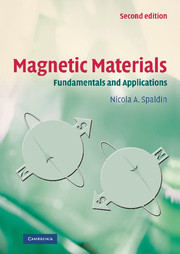11 - Anisotropy
from II - Magnetic phenomena
Published online by Cambridge University Press: 05 June 2012
Summary
… could it work so much upon your shape
As it hath much prevail'd on your condition,
I should not know you, Brutus.
William Shakespeare, Julius CaesarThe term “magnetic anisotropy” refers to the dependence of the magnetic properties on the direction in which they are measured. The magnitude and type of magnetic anisotropy affect properties such as magnetization and hysteresis curves in magnetic materials. As a result the nature of the magnetic anisotropy is an important factor in determining the suitability of a magnetic material for a particular application. The anisotropy can be intrinsic to the material, as a result of its crystal chemistry or its shape, or it can be induced by careful choice of processing method. In this chapter we will discuss both intrinsic and induced anisotropies in some detail.
Magnetocrystalline anisotropy
In Chapter 7 we introduced the concept of magnetocrystalline anisotropy, which is the tendency of the magnetization to align itself along a preferred crystallographic direction. We also defined the magnetocrystalline anisotropy energy to be the energy difference per unit volume between samples magnetized along easy and hard directions. The magnetocrystalline anisotropy energy can be observed by cutting a {110} disk from a single crystal of material as shown in Fig. 11.1, and measuring the M–H curves along the three high-symmetry crystallographic directions and contained within the disk.
Schematic results for single-crystal samples of ferromagnetic metals such as iron and nickel were shown in Fig. 7.4. Body-centered cubic Fe has the 〈100〉 direction as its easy axis.
- Type
- Chapter
- Information
- Magnetic MaterialsFundamentals and Applications, pp. 135 - 144Publisher: Cambridge University PressPrint publication year: 2010



